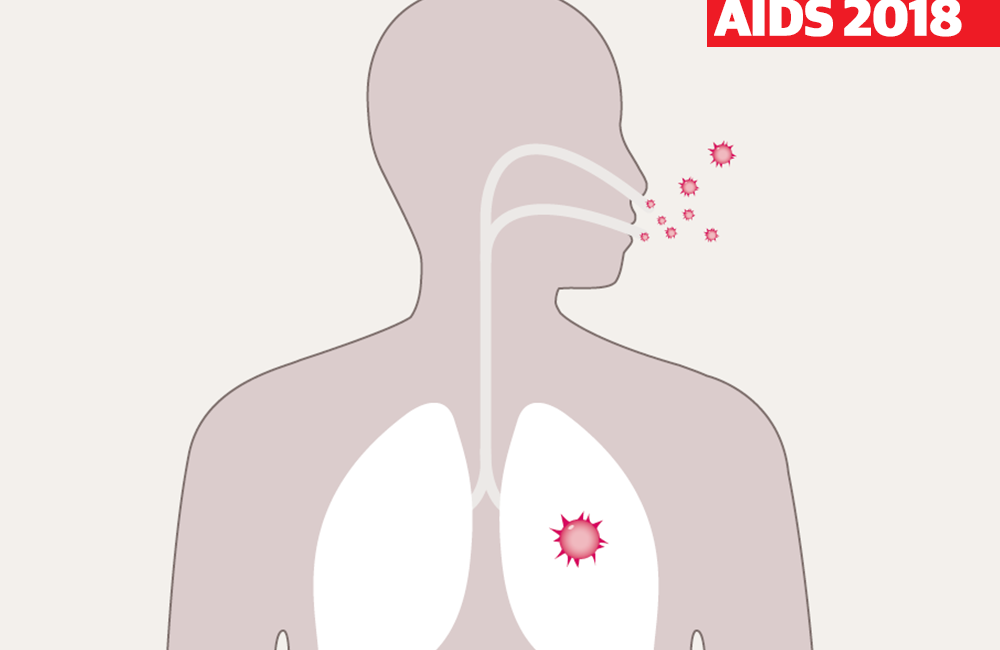
Dolutegravir-based antiretroviral therapy (ART) is effective and safe when taken at the same time as standard tuberculosis (TB) therapy, according to an international study presented at the 22nd International AIDS Conference (AIDS 2018), held in Amsterdam in July.
After 48 weeks of therapy, 75% of people had an undetectable viral load, comparable to the rate of viral suppression observed among people treated with efavirenz. The treatment was safe, with few people experiencing serious adverse events and reported side-effects were generally mild. TB therapy was successful in almost all people.
ART based on dolutegravir is now recommended by the World Health Organization as a preferred regimen for both first- and second-line therapy. Dolutegravir-containing therapy is known to have good long-term virological efficacy and a favourable safety profile. Moreover, the drug also has a high barrier to resistance and low potential for interactions with other medications.
Establishing the efficacy, safety and optimum dose of dolutegravir for HIV-positive people who are also taking therapy for TB is a current research priority. Efavirenz-based ART is widely used in the context of HIV/TB co-infection, but alternative regimes are needed, especially because of this drug's side-effect profile and also in settings where there is a high rate of transmitted resistance to efavirenz and other drugs in the non-nucleoside reverse transcriptase inhibitor (NNRTI) class.
Research has already established that, when taken in combination with the anti-TB drug rifampin, twice-daily 50mg dose of dolutegravir is well tolerated and achieves dolutegravir concentrations similar to those observed with standard once-daily 50mg dolutegravir therapy.
Investigators designed a 48-week study to establish the virological efficacy and safety of ART based on dolutegravir 50mg twice daily in people taking rifampin-based TB treatment.
The phase IIIb study was multi-centre and open-label. A total of 113 people were recruited at 37 sites in seven low- and middle-income countries. The participants were randomised to receive dolutegravir or efavirenz.
The study was not intended to be comparative, and the primary end-point was the proportion of dolutegravir-treated people with a viral load below 50 copies/ml after 48 weeks of therapy. Data were also gathered on virological response among the efavirenz-treated people, changes in CD4 cell count, the incidence and severity of adverse events and side-effects, the rate of TB- and non-TB-related immune reconstitution inflammatory syndrome (IRIS), the proportion of people discontinuing therapy or developing resistance and the success of TB therapy.
A total of 69 people were randomised to receive dolutegravir and 44 to take efavirenz. The two groups were well matched. Median age was 32.5 years, between 36% and 43% were female, median viral load was 125,000 to 160,000 copies/ml and baseline CD4 cell count was a little over 200 cells/mm3. Two-thirds of people took the study drug in combination with tenofovir/emtricitabine. Almost all the participants had pulmonary TB.
The intent-to-treat analysis showed that after 48 weeks of therapy, 75% of people randomised to dolutegravir had an undetectable viral load, as did 82% of those randomised to efavirenz. The proportion of people without a virological response was 9% and 7%, respectively, with a further 16% and 11%, respectively, stopping therapy for other reasons.
Median CD4 cell count increased from baseline by 220 cells/mm3 among people taking dolutegravir and by 190 cells/mm3 among the efavirenz-treated individuals. Plasma dolutegravir concentrations were well within the therapeutic range.
TB therapy was successful in 88% of people randomised to dolutegravir and 91% of people randomised to efavirenz.
Most people reported a side-effect. But for the most part, these were mild.
A drug-related adverse event was recorded in a quarter of people taking dolutegravir and a third of efavirenz-treated people. Serious adverse events were rare, occurring in 4% of people in each treatment group. None of the people taking dolutegravir stopped therapy because of an adverse event.
There was a low incidence of TB-related and non-TB-related IRIS (7% for dolutegravir; 9% for efavirenz). Very few people experienced significant elevations in liver enzymes and none stopped treatment because of drug-induced liver injury.
On the basis of these findings, the investigators concluded that dolutegravir 50mg twice daily in combination with other antiretrovirals is effective and well tolerated in adults with HIV/TB co-infection who are also receiving rifampin-based TB treatment.
Dooley KE et al. INSPIRING: safety and efficacy of dolutegravir-based ART in TB/HIV co-infected adults at weeks 48. 22nd International AIDS Conference (AIDS 2018), Amsterdam, abstract TUAB0206, 2018.
View the abstract on the conference website.
Download the slides from the conference website.
Watch the webcast of this session on YouTube.
Update: Following the conference presentation, this research was published in a peer-reviewed journal:
Dooley KE et al. Dolutegravir-based antiretroviral therapy for patients coinfected with tuberculosis and human immunodeficiency virus: a multicenter, noncomparative, open-label, randomized trial. Clinical Infectious Diseases, 70: 549-556, February 2020.
